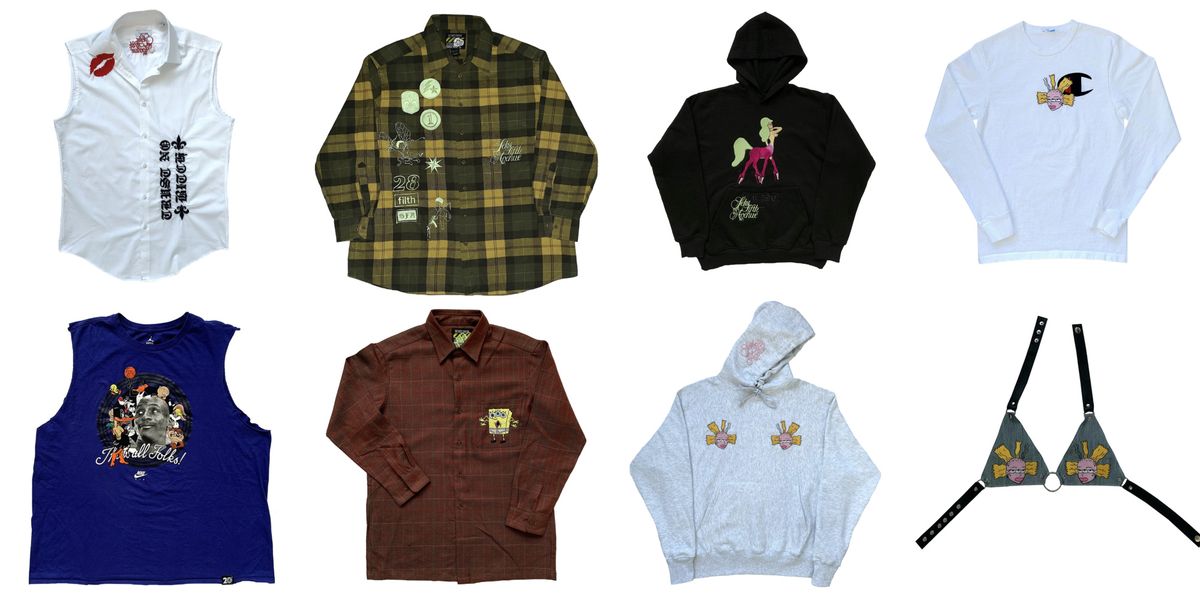
The repurposing of old and deadstock fabrics is not a new practice in the fashion world. Big names like Alexander McQueen to independent labels like Duran Lantink have all designed collections using discarded materials. But brands have increasingly become more vocal about their sustainability credentials as the industry grapples with its production methods and their impact on the environment.
Seks 5th Avenue, the sustainable clothing brand with its cheeky name nodding to the famed department store, is a small but growing label employing the practice. Pronounced "sex," they upcycle existing clothing into completely new pieces designed by hand. According to the brand, all pieces are genderless and meant to be worn at any size, with new items in stock on its web store every Tuesday.
The brand also showcases new designs on Instagram: everything from patchwork jeans to cartoon graphic tees. PAPER caught up the people behind the account to learn more about their process.
How did the idea behind Seks 5th Avenue come about?
Seks 5th Avenue was founded this September, 2019 in NYC by MC and producer F. Virtue and Abel Ljoka, a skilled designer who trained under The Blonds, as a way to further develop Abel's runway brand, Santa Monroe. SM has dressed Lady Gaga's Roseland Ballroom closing shows, Nick Jonas, Rose McGowan, and more, and is in the slow process of developing their official debut via their true first collection. So Seks began as a way to create and release products in the meantime, while serving as a platform to have fun, experiment, train, toil, and save for Santa Monroe's eventual launch.
Why did you decide to name it after Saks the department store?
At its heart, Seks 5th Avenue is filthy, it's New York, and it subverts and sexualizes big industry and its iconic imagery, and due to our love of giving life to deadstock, we also have a fascination with department stores, so what more fitting name?
Where do you source your discarded garments from and what sort of pieces do you end up creating?
Our source material comes from factory defects, deadstock, and our personal closets. We're both active in the NYC queer club scene, and we almost always get ideas for our looks super last minute and end up making pieces out of necessity using whatever we have and could find. One time after a flash of inspiration from the MET's "Camp" exhibition before a party we hosted, Abel was on the kitchen floor sewing squares of scarves together and to our shirts and to our pants right up until we walked in the Uber. This mentality is very Seks, we use what we have available, the world's mountains of forgotten clothing, and create fresh — sometimes experimental, sometimes straightforward — pieces for those who get it.
"At its heart, Seks 5th Avenue is filthy, it's New York, and it subverts and sexualizes big industry."
I've noticed you use Sinthia a lot in your designs, can you explain why?
We're building a kingdom of characters, turning childhood cartoons into adults — some mutantified, some sexified, some both, and all cunt... like us as we grow. Our sweet little Sinthia is especially beloved, but you can tell she doesn't care either way.
What's behind the brand's tagline? ("We Turn Trash Into Trash")
We elevate trash. Our source material is often garments that were discarded or collecting dust, and though we give them a second chance, we don't take anything too seriously and know that this is all just trash someday no matter what it is. We can't take anything with us.
Do you take private/custom orders?
Custom orders and commissions are our specialty. We can literally do anything, including embroidery, digitizing, and patterning, and believe in the art of handmade 1-of-1s, so if there is ever anything anyone wants done, on any scale, hit us up! We can make it happen.
Photos via Instagram
From Your Site Articles
- Seks Fifth Avenue Turns Discarded Fabrics Into New Creations ... ›
- Seks on Their First Collaboration With Hanes ›
- Cult Fav SEKS Drops Weed and Fashion Collections ›
- Celebrity Fav Brand SEKS Is About To Be Bigger Than Ever ›
- Seks 5th Avenue Releases "FℲucK the Police (Ballroom Law)" - PAPER Magazine ›
Related Articles Around the Web